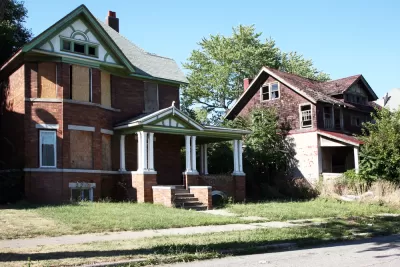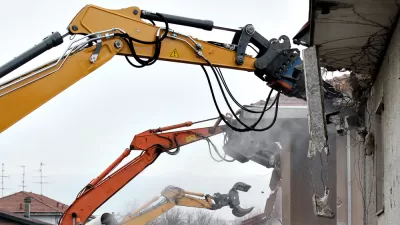A recent influx of money to Detroit for demolitions of abandoned properties brings the city's total to $107 million. That money has established Detroit as the country's proving ground for the idea that demolitions stabilize struggling neighborhoods.

"The City of Detroit stands to receive an additional $21.25 million in demolition money from the federal government under a proposal authorized by the Obama administration and approved Wednesday by a state housing board," report Todd Spangler and Paul Eggan. "The money will be enough to take down nearly 1,300 blighted structures if recent averages hold."
The funding comes by way of the U.S. Treasury, which essentially allowed the Michigan State Housing Development Authority "to move another $32.7 million of a $498-million award made in 2010 under the Hardest Hit Fund." According to Spangler and Eggan, the recent influx of money (split between Detroit and Flint) "marked the third time Treasury has allowed the state to move money from other home-ownership protection efforts under the program into demolition, which state and city officials have argued can do more in some municipalities to help stabilize struggling neighborhoods."
The money gives the Detroit Land Bank funding to operate through April. Flint had already ceased demolitions due to lack of funds. The article also notes, importantly, that costs have gone up on average for demolitions in Detroit—to $16,400 per demolition from about $10,000 in 2014. Matt Helms and Joe Guillen report on the increased demolition costs, and the pushback they've provoked, in a separate article.
FULL STORY: Detroit to get $21 million more for blight demolition

Planetizen Federal Action Tracker
A weekly monitor of how Trump’s orders and actions are impacting planners and planning in America.

Congressman Proposes Bill to Rename DC Metro “Trump Train”
The Make Autorail Great Again Act would withhold federal funding to the system until the Washington Metropolitan Area Transit Authority (WMATA), rebrands as the Washington Metropolitan Authority for Greater Access (WMAGA).

The Simple Legislative Tool Transforming Vacant Downtowns
In California, Michigan and Georgia, an easy win is bringing dollars — and delight — back to city centers.

The States Losing Rural Delivery Rooms at an Alarming Pace
In some states, as few as 9% of rural hospitals still deliver babies. As a result, rising pre-term births, no adequate pre-term care and "harrowing" close calls are a growing reality.

The Small South Asian Republic Going all in on EVs
Thanks to one simple policy change less than five years ago, 65% of new cars in this Himalayan country are now electric.

DC Backpedals on Bike Lane Protection, Swaps Barriers for Paint
Citing aesthetic concerns, the city is removing the concrete barriers and flexposts that once separated Arizona Avenue cyclists from motor vehicles.
Urban Design for Planners 1: Software Tools
This six-course series explores essential urban design concepts using open source software and equips planners with the tools they need to participate fully in the urban design process.
Planning for Universal Design
Learn the tools for implementing Universal Design in planning regulations.
Smith Gee Studio
City of Charlotte
City of Camden Redevelopment Agency
City of Astoria
Transportation Research & Education Center (TREC) at Portland State University
US High Speed Rail Association
City of Camden Redevelopment Agency
Municipality of Princeton (NJ)





























